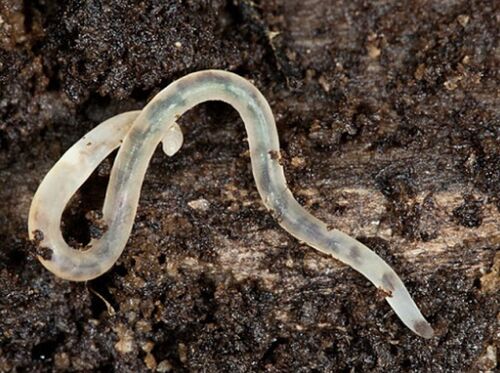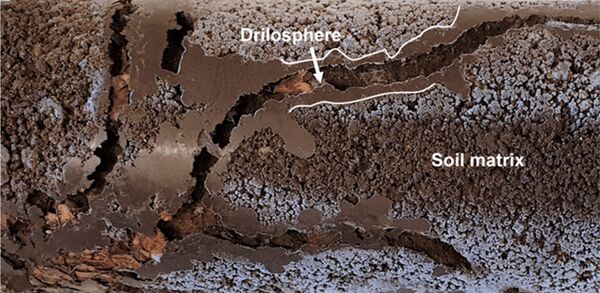Pot Worms
Pot worms are a group of normally colorless terrestrial worms in the family enchytraeidae. The family is made up of microdrile oligochaetes living mainly in highly organic terrestrial environments. The term microdrile oligocates refers to their small size in combination with their resemblance to earthworms. Like earthworms, pot worms are in the phylum Annelida.
Taxonomy
| Kingdom | Phylum | Class | Order | Family |
|---|---|---|---|---|
| Animalia | Annelida | Clitellata | Tubificida | Enchitraeidae |
Appearance
Image of a pot worm in soil. [2]
Pot worms, while similar in appearance to earthworms, are slim, colorless, and small. Like earthworms, they are segmented annelids. However, they only grow about 5 to 15 mm in length. [3] While they are visible to the naked eye, they are best seen under a microscope due to their small size. These worms are often referred to as being “white” in color despite them being colorless. This is because they often appear white to the naked eye. Due to their transparency, the contents of their digestive system are often visible to the naked eye. This makes the pot worms appear clear to white in color with a brown “stripe” down the middle. This dark “stripe” is created from the detritus, bacteria, and fungi consumed as they create their burrows.
Distribution and Habitat
Distribution
These worms are found throughout much of the world. As seen with earthworms, pot worms are found globally in moist terrestrial environments. They are historically most likely to be found in cool temperate regions of the Earth. [1]
Habitat
Pot worms are commonly found in organically rich terrestrial soils. These soils are rich in CHON (carbon, hydrogen, oxygen, and nitrogen) and usually very moist. They inhabit areas rich in detritus, bacteria, and fungi as they use these materials to create soil humus as they absorb environmental nutrients during burrowing activities. Their burrows must maintain some moisture so that the worms do not experience desiccation. While they are found in terrestrial environments worldwide just like earthworms, they are more common than earthworms in some circumstances. It is seen that in cold, wet, and organic rich ecosystems with low pH pot worms become more populous than earth worms. [6] They are also very commonly found in moist garden compost. [1]
Diet
Similar to megadrile oligochaetes, earthworms, pot worms consume leafy matter and detritus. However, they gain most of their nutrients from consuming fungal hyphae and bacterial material along with excretions from other soil organisms. [1] This occurs because their smaller size makes it harder for them to consume detritus in the same way as earthworms are able to. Small fungal and bacterial materials are more easily consumed by these small annelids. They consume these decaying materials as they move along channels in the soil. During this process, detritus, plant materials, and organic debris are transformed into soil humus.
Ecosystem Impacts
Despite their small size, pot worms contribute to the alteration of soil structures. They serve to alter soil porosity due to burrowing activities. [1] This burrowing also helps to aerate the soil providing oxygen for soil organisms. They also produce worm castings and mucus secretions which greatly improve the soil quality by influencing the bacterial and mineral content surrounding their burrows. These areas surrounding their burrows is referred to as the driloshpere. These burrowing and decompositional activities transform decaying materials into humus. [3] Soil humus is the rich, dark, organic matter left behind from decomposition. [4] This organic material allows for more nutrients in the soil structure. Not only do pot worms help to create soil humus but, their burrowing activities play a key roll in mixing the organic matter with the existing soil.
Image of the driloshpere surrounding the burrow or an annelid. This is created from the mucus secreted during burrowing activities. The mucus helps soil particles to cohere to one another. [5]
References
Citations
- “All about Enchytraeidae: White Pot Worms.” A Chaos of Delight , https://www.chaosofdelight.org/enchytraeidae-1.
- “5 Different Types of Worms in Potted Plants.” India Gardening , 30 Mar. 2021, https://indiagardening.com/lists/types-of-worms-in-potted-plants/.
- Loynachan, Tom. “Multimedia Gallery | Soil Science Society of America.” Soil Science Society of America , Iowa State University, https://www.soils.org/media-gallery/view/60.
- “Humus.” Education , National Geographic, https://education.nationalgeographic.org/resource/humus/.
- “Example of Burrows in a Soil Column after 28 Days Showing the ...” Research Gate , https://www.researchgate.net/figure/Example-of-burrows-in-a-soil-column-after-28-days-showing-the-drilosphere-and-soil-matrix_fig1_356883014.
- “Enchytraeids (Potworms).” WUR , https://www.wur.nl/en/Research-Results/Chair-groups/Environmental-Sciences/Soil-Biology-Group/Research/The-Soil-Biota/Enchytraeids-potworms.htm.

